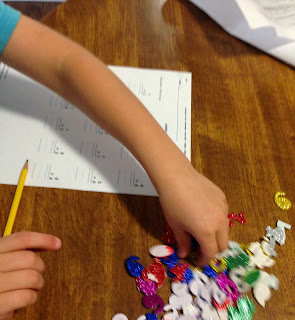My son loves to listen to books, and looks forward to our daily reading time. Now that we are working on kindergarten, I am using questions during reading time to cover
Common Core objectives. Tonight I need to figure out what we have done and what we need to to do. Here is the list of questions we have used or will use to finish covering Reading and Literature objectives.
Reading: Literature
Tell me about [key details in the text]. (RL. K.1 )
Now that I have read this story to you, you tell it to me. (RL. K.2)
Who is the most important character in this story/poem?
Who else is in this story/poem?
Where did this story happen?
What happened in this story/poem ? (RL.K.3)
What do you think the word [unknown word from book] means? (RL.K.4)
What words from this story/poem are new to you? (RL.K.4)
What kind of book is this? (RL.K.5)
Who is the author of this book?
What does it mean to be the author?
Who is the illustrator of this book?
What does the illustrator do? (RL.K.6)
What is happening in this picture? (RL.K.7)
How is this story like [another story read recently]?
How is this story different from [another story read recently]?
(Actively engage in group reading activities with purpose and understanding, RL.K.10)
Reading:Informational Text
Tell me about [key details in the text]. (RI. K.1 )
What is this book about?
What are the most important things to know about [main subject of the book] (RI.K.2)
What does [person, event, idea, fact] have to do with [second person, event, idea, or fact]? (RI.K.3)
What do you think the word [unknown word from book] means? (RI.K.4)
Show me the front cover of this book.
Show me the back cover of this book.
Show me the title page of this book. (RI.K.5)
Who is the author of this book?
What does it mean to be the author?
Who is the illustrator of this book?
What does the illustrator do? (RI.K.6)
What is happening in this picture? (RI.K.7)
Why does the author say [point made in the text]? Note: The reasons should be derived from the text. (RI.K.8)
What other book have read recently on this topic?
How are [two books on the same topic] the same?
How are [two books on the same topic] different? (RI.K.9)
(Actively engage in group reading activities with purpose and understanding, RI.K.10)
Italics mean that this question is the same for both literature and informational texts.
In addition to our reading times at home, my children participate in a reading time at our local library our home school co-operative. These extra activities give them some opportunity to engage in group reading activities as per RL.K.10, and RI.K.10.
Now that I have made my list,
I will choose six or so of the questions that we have not thoroughly covered, and write them on an index card and place the card on the kids' bookshelf to remind me what I need to be asking during Monday's reading time.
Are there other questions you would use during reading time with a five-year-old?





















